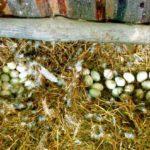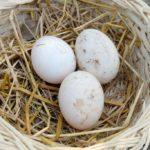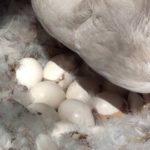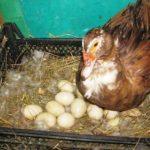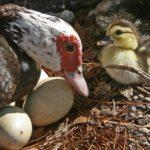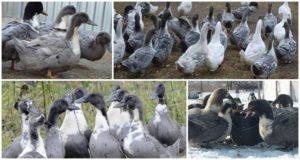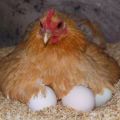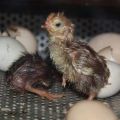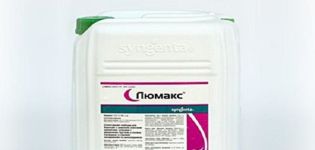How many eggs can be placed under the indoctuka and will the clutch of other birds survive
This type of poultry has a good, calm temperament, disease resistance and food picky. Along with this, she quickly gains weight and has a pronounced maternal instinct. But for successful breeding of the breed, the owners must know how many eggs can be placed under each Indoor to get the maximum number of chicks.
How many eggs can I put under an indo
Oviposition in birds of this breed begins at the age of six months. The total number of eggs that a hen produces in one cycle is 60-85 pieces. Moreover, when their number in the nest reaches 12-15 pieces, the Indo-female is able to hatch them herself. These birds are by nature excellent hens, they have a pronounced maternal instinct. If all the requirements are observed by the owners of the poultry, Indo-ducks have a consistently high percentage of offspring - up to 90-94%.
From the beginning of clutching and after the brood itself, the muscovy duck anxiously takes care of the offspring, practically without requiring additional human intervention. The exception is the process of feeding and maintaining good conditions. The number of eggs that can be placed under the indochka directly depends on the size of the bird itself.
It is logical that the larger the female is, the more she will be able to hatch the chicks. In no case should the eggs be allowed to fall out or look out from under the hen sitting on them. Otherwise, they will not have enough maternal warmth, and some of the offspring may not be born. Also, the owners should remember that during the spring or autumn period, an Indo-female can produce offspring 2-3 times, and she can hatch no more than 25 chicks at a time.
How to do it?
The clutch, which the owners plan to put under the bird, should not be kept in storage for more than 18 days. During the resting period, eggs should be in an upright position, with a sharp tip up. Once a day, they are rotated 90 degrees along the vertical axis, and this is done quite carefully and carefully. The room temperature should not exceed +14 C degrees. It is important to remember that the shell is covered with a protective film - a cuticle that protects the embryos from sudden drying out.
This shell is destroyed by the action of the liquid, so you cannot wash the masonry from which it is planned to breed. Also, the owners need to closely monitor the sanitary condition of the nests on which the Indo-girls will sit. Weak embryos are susceptible to various infections, therefore, excessive contamination of the masonry by the hen should not be allowed.The microbes in the droppings can quickly dissolve organic protein and make the eggs unsuitable for hatching.
For this, dummies are placed in her nest. Then, when the bird gets used to them, they imperceptibly, when the duck leaves the nest, are replaced with real, already fertilized eggs. It is important to remember that it is advisable not to change the place where the bird used to sit for a new one. For her, everything should be familiar and familiar. On average, to hatch ducklings, the owners lay 15-20 eggs under this breed of birds.

Can other birds lay eggs?
Thanks to the developed maternal instinct and calm, balanced nature, Indo-women are excellent hens. These qualities are used by experienced owners, using birds to breed eggs from ducks of other breeds, chickens and even turkeys.
But you should carefully approach this issue and remember that Indo-girls can roll out someone else's clutch from their nest.
Chicken
Putting chicken eggs under the indoctka must be carefully and carefully. Hosts must consider several important factors before lining:
- the period of incubation of offspring in chickens is shorter than that of Indo-ducks and is usually 20-24 days, and in muscovy ducks - 32-36 days. Therefore, it is necessary to check for the presence of offspring born in order to save it in time. Otherwise, the chickens may die from lack of oxygen or the brood hen, upon finding strangers, will simply bite them;
- body temperature in chickens is three degrees lower than that of Indo-cows. This may well have a negative effect on the embryos, they can slow down in development or simply die.
Turkey eggs
Birds of this breed cope with incubation of turkey eggs without any problems. They have a similar incubation period, so do not be afraid that the hen will get off the nest ahead of time. It is recommended to put up to 15 pieces under the musky duck and turn them over from time to time.
Goose
When laying goose eggs, it is necessary to turn them over daily - the Indo-woman will not be able to do this on her own. After 10 days, they begin to discard the dead embryos, and after 2 weeks, they begin to spray the eggs with warm water, this will help the chicks break through the dense shell.

